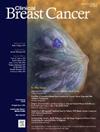The Systemic Immune-Inflammation Index is a Predictor of Chemotherapy Sensitivity and Disease-Free Survival in Patients With Hormone Receptor-Positive Human Epidermal Growth Factor Receptor 2-Negative Breast Cancer
IF 2.9
3区 医学
Q2 ONCOLOGY
引用次数: 0
Abstract
Background
The relationship between the systemic immune-inflammation index (SII), chemotherapy sensitivity, and prognosis in HR+HER2– breast cancer (BC) has not been extensively studied.
Patients and methods
Clinical data from 980 patients diagnosed with HR+HER2– BC between June 2012 and June 2016 were collected. Patients were divided into low- and high-SII groups according to median SII value. Differences among variables were assessed using the chi-squared test. The inverse probability of treatment weighting (IPTW) method was used to control bias. The associations between clinicopathological factors, baseline SII, and disease-free survival (DFS) were analyzed using Kaplan–Meier curves and Cox analyses.
Results
The median follow-up period was 37 months (5-77). 480 patients underwent neoadjuvant chemotherapy, and low baseline SII values were associated with higher pathological complete response (pCR) rates than those in the high SII group (16.4% vs. 9.2%; P = .019). Multivariate analyses revealed that larger tumor size, more lymph node involvement, high Ki-67 score, and high baseline SII were independent prognostic factors for worse outcomes in patients with HR+HER2– BC. The risk for metastasis/recurrence was higher in the high SII group compared with that in the low SII group (hazard ratio 2.07 [95% CI, 1.35-3.19]; P = .001). After IPTW, a similar result was obtained, in that a high SII value was significantly associated with worse DFS among patients with HR+HER2– BC.
Conclusion
A low baseline SII was associated with higher pCR rates after neoadjuvant chemotherapy and was an independent prognostic factor for better DFS outcomes in patients with HR+HER2– BC.
全身免疫炎症指数是激素受体阳性人类表皮生长因子受体 2 阴性乳腺癌患者化疗敏感性和无病生存期的预测因子
背景:HR+HER2-乳腺癌(BC)患者全身免疫炎症指数(SII)、化疗敏感性和预后之间的关系尚未得到广泛研究:尚未广泛研究HR+HER2-乳腺癌(BC)患者全身免疫炎症指数(SII)、化疗敏感性和预后之间的关系:收集2012年6月至2016年6月期间确诊为HR+HER2-BC的980名患者的临床数据。根据 SII 中位值将患者分为低 SII 组和高 SII 组。变量之间的差异采用卡方检验进行评估。采用逆概率治疗加权法(IPTW)控制偏倚。采用 Kaplan-Meier 曲线和 Cox 分析法分析了临床病理因素、基线 SII 和无病生存期(DFS)之间的关系:中位随访期为 37 个月(5-77 个月)。480名患者接受了新辅助化疗,与高SII组相比,低基线SII值与更高的病理完全反应率(pCR)相关(16.4% vs. 9.2%; P = .019)。多变量分析显示,肿瘤体积较大、淋巴结受累较多、Ki-67评分较高和基线SII较高是导致HR+HER2- BC患者预后较差的独立预后因素。与低SII组相比,高SII组的转移/复发风险更高(危险比2.07 [95% CI, 1.35-3.19];P = .001)。IPTW后也得出了类似的结果,即在HR+HER2- BC患者中,高SII值与较差的DFS显著相关:结论:低基线SII与新辅助化疗后较高的pCR率相关,并且是HR+HER2- BC患者较好DFS结果的独立预后因素。
本文章由计算机程序翻译,如有差异,请以英文原文为准。
求助全文
约1分钟内获得全文
求助全文
来源期刊

Clinical breast cancer
医学-肿瘤学
CiteScore
5.40
自引率
3.20%
发文量
174
审稿时长
48 days
期刊介绍:
Clinical Breast Cancer is a peer-reviewed bimonthly journal that publishes original articles describing various aspects of clinical and translational research of breast cancer. Clinical Breast Cancer is devoted to articles on detection, diagnosis, prevention, and treatment of breast cancer. The main emphasis is on recent scientific developments in all areas related to breast cancer. Specific areas of interest include clinical research reports from various therapeutic modalities, cancer genetics, drug sensitivity and resistance, novel imaging, tumor genomics, biomarkers, and chemoprevention strategies.
 求助内容:
求助内容: 应助结果提醒方式:
应助结果提醒方式:


